Infrared heaters are the best choice for heating your home with maximum benefit!
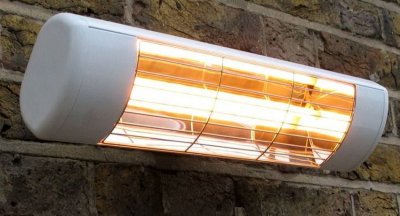
One of the varieties of heating devices is an infrared heater. It increases the temperature in the room due to infrared radiation.
By acting on furniture and household appliances, the energy they receive is converted into heat, which heats the air.
Content
- Infrared heater design
- Operating principle
- Features of gas and electric appliances
- Technical specifications
- Wavelength
- Advantages and disadvantages
- Options for using the equipment in an apartment, wooden house and other buildings
- Approximate cost
- Types of models
- How to choose a heater with infrared radiation
- Features of operation
- Useful video
- Which device is better to choose for heating a private house
Infrared heater design
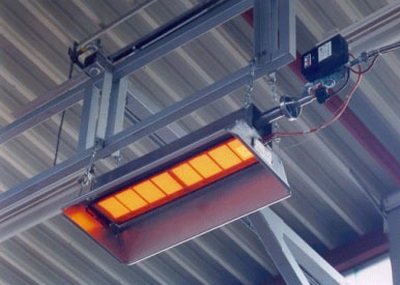
Main components:
- rectangular body, made of metal, painted outside and inside with heat-resistant paint;
- heating element made of stainless steel;
- aluminum reflector, which has an anodized coating that improves the principle of heat reflection;
- control unit, located inside the device;
- rollover sensor;
- protective foil layer;
- thermostat;
- fire hazard sensors, automatically switching off the device;
- special ceiling mount or metal stand (depending on the type of infrared heater).
Operating principle
The device operates on the principle of obtaining thermal radiation. from converted electrical energy. This happens due to the heating element heating up, then the heating plate, which emits infrared radiation.
Reference. The device in question, unlike traditional ones, it heats objects, not the air, located indoors. It occupies a few minutes.
By directing the heater in a certain direction, it will initially heat up some object, which will give off heat for a long time. At the same time, the air in another part of the living space will remain cool. This makes it possible to warm up quite quickly.
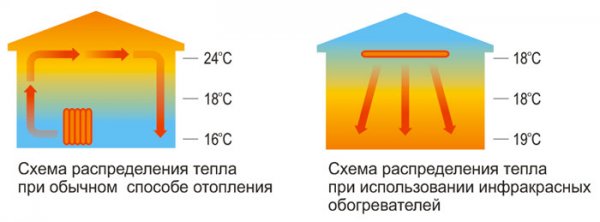
Photo 1. Heat distribution diagram in a house using heating radiators (left) and infrared heaters (right).
Features of gas and electric appliances
There are two types of infrared heaters: electric and gas. In the first, heating occurs due to the presence of a heating element, a carbon spiral, a micathermic panel, and a halogen lamp. In gas appliances, a special ceramic element is installed, which emits infrared radiation.
Some of the features include:
- economy;
- environmental safety;
- service life more than 20 years;
- attractive design;
- Possibility of installation in large cafes and small rooms;
- completely safe for health.
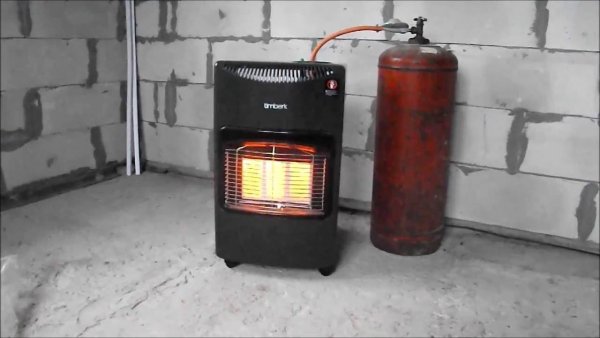
Photo 2. Gas infrared heater. The device operates using liquefied gas in a cylinder.
Technical specifications
In addition to wavelength, power, and placement method, one of the technical characteristics of these devices is the type of heating element. According to this, the following types of devices are distinguished:
- Ceramic — heat the panels using a metal thread that has high resistance. They are exclusively wall and ceiling mounted.
- Halogen quickly heat up the living space. Disadvantage: they glow brightly.
- Tubular (quartz, carbon lamps) are compact in size and distribute heat evenly throughout the living space.
- Based on a gas burner — can be used on hikes, in summer cottages, during power outages. They are distinguished by their mobility.
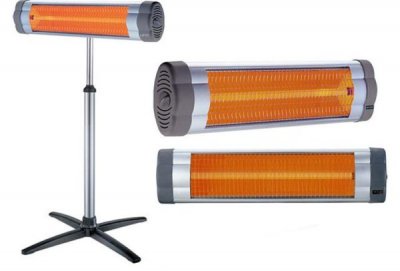
Technical specifications, depending on location:
- Floor: maximum power 400 W, are capable of heating the surface up to 60 °C, wavelength up to 10 microns, weight fluctuates from 820 g to 7.8 kg.
- Wall mounted: power within 300-800 W, heat the surfaces up to 85 °C, wavelength up to 10 microns, the weight is on average 2.25-18 kg.
- Ceiling: power from 600 to 6000 W, operate on medium and long waves, the maximum weight of the device is 35 kg.
Wavelength
According to the spectrum of infrared rays, the following are distinguished:
- short waves, the length of which 0.74-2.5 µm. Operating temperature above 800 °C;
- average - 2.5—50 µm;
- long - 50-1000 µm. Operating temperature 300—400 °C.
Advantages and disadvantages
Advantages:
- low energy consumption when using an infrared heater;
- the space is heating up in a few minutes;
- the temperature in the room is closer to the floor and ceiling becomes the same;
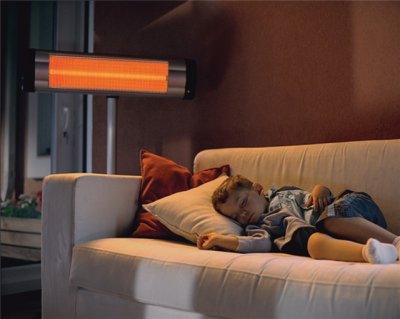
- makes it possible to implement zoned heating;
- due to its compact size, the way it can be placed on the ceiling or wall (some models) the heater does not take up much space;
- does not make noise in the process of work;
- does not dry the air;
- cannot provoke the appearance of drafts, raising dust in the air;
- accessible, easy electronic control not labor-intensive;
- does not require special skills for installation (we are talking about floor and wall models);
- Suitable for any interior.
Flaws:
- Ceiling models are capable of heating the air under the ceiling (the heated body gives off some of the heat into the room), which does not move further around the room.
- Bright light from radiation not always pleasant for the eyes at night.
- High cost of more advanced models.
- When cooling and heating, a crackling sound is often heard from the device, which occurs due to the combination of different materials in the device.
Options for using the equipment in an apartment, wooden house and other buildings
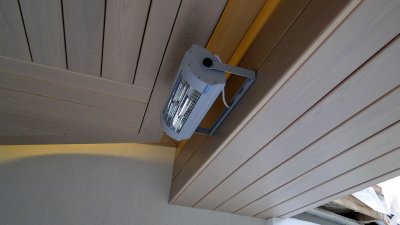
Depending on the size, an infrared heater is used in an apartment, a private house, in a production facility, a stadium, an open summer area, or in hospitals.
It is known to be used at railway stations, in gazebos, and on balconies.
At the same time the main thing is to be in the infrared radiation zone.
Reference. With the help of such heaters drying painted parts in production, and also accelerate the hardening time of reinforced concrete structures.
Approximate cost
The price of such devices varies significantly depending on the presence of additional functions, heating element, power, size and other indicators in the devices. Their minimum cost is 510 RUR., maximum — 242 139 RUR
Types of models
In stores today There are different types of infrared heaters available for purchase. Let us consider them in more detail, pointing out their main features.
Energy saving ceiling
Such models are placed using fasteners that are mounted to the ceiling at a height from 2.4 to 3.5 m. These parameters can be changed using adjustable cables. Such a heater must be installed at a distance not less than 3 or 5 cm from the ceiling.

Photo 3. Ceiling infrared heater in a private wooden house. The device is located at some distance from the ceiling.
Their peculiarity is that ceiling devices are most often placed in garages, offices, open summer areas, cafes, summer cottages. In some cases they can be used to increase the temperature in greenhouses.
Wall mounted
Serve as an independent source of heating in rooms of various sizes. Wall-mounted devices must be equipped with a thermostat, which can not only regulate the heating temperature, but also set the time for turning the device on and off.
Hang the analyzed devices at a distance at least 5 cm under windows or above doorsDepending on the cost, heaters can have beautiful painting, decorative finishing with stone, tiles.
Attention! Experts advise purchasing regular heaters that are not painted with additional paint, since low-quality paint can emit smoke during the heating process. substances harmful to the body.
Floor standing
Most of these models are portable.If the device is heavy, it must be additionally equipped with wheels, which facilitates the process of its transportation.
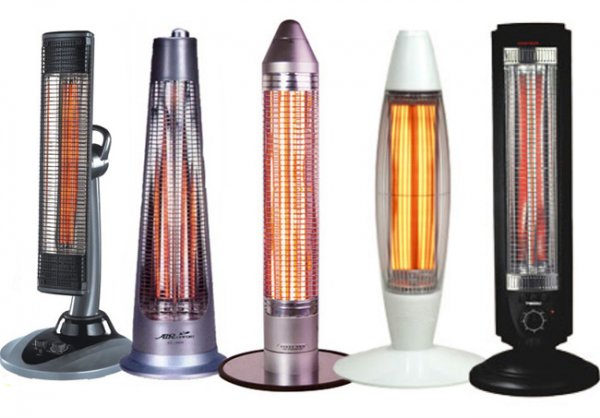
Photo 4. Several floor infrared heating lamps. The products serve not only for heating, but also for interior decoration.
Their peculiarity is that floor infrared heaters are used exclusively as an additional source of heat. It is prohibited to install them in an apartment next to a sofa, armchair, or socket.
Important! During use, make sure that the cord does not overheat. Otherwise, it may cause to melting of wiring and short circuit.
How to choose a heater with infrared radiation
Before you purchase an infrared heater, you need to pay attention to certain criteria, which will help you choose a model for a residential or industrial space.
Types of infrared heaters:
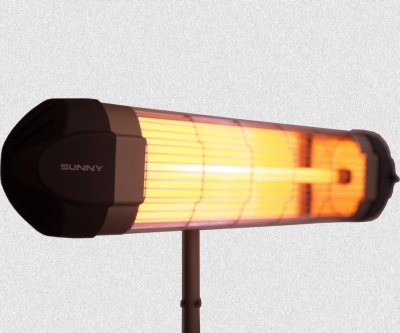
- film;
- floor;
- ceiling;
- wall-mounted;
- in the form of a picture;
- baseboards;
- industrial;
- glass;
- infrared convective;
- halogen;
- electrical;
- ceramic;
- micathermic;
- diesel.
Ratio of footage to power
According to standard requirements per 10 square meters you need to have a heater with a power of 1000 W. In this case, it is taken into account whether there will be other heat sources in the room, how insulated the building is, what condition the doors and windows are in. According to such parameters, the power should be adjusted individually.
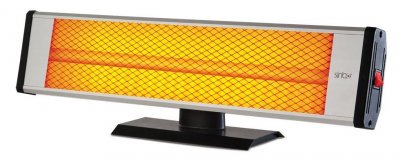
To heat a small garage or basement, a device with a power of up to 300 WTo increase the temperature in cool weather in a summer house, it is worth purchasing a device with a power 60-80 W from the calculation per 1 square meter.
Power
- From 100 to 400 W. Reach maximum temperature in 60 °C. They are most often used in kindergartens and schools.
- From 400 to 600 W are warming up up to 100 °C. Installed in offices.
- From 600 to 1000 W have a maximum temperature 280 °C. They are placed in residential buildings, apartments, industrial facilities, cafes, and shops.
- From 1000 W. Such a device can heat up even more than up to 300 °C. They are used exclusively for open balconies, terraces, and summer areas.
On the waves
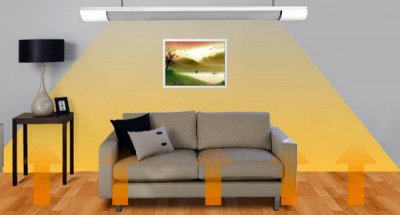
When choosing a heater you like and studying its wavelength, pay attention, first of all, to the height of the ceilings in the room where it will be installed. Depending on this, the following are distinguished:
- longwave (5.6— 100 µm) for ceiling height up to 3 m;
- medium wave (1.5-5.6 µm) with height 3-6 m;
- shortwave (0.75-1.5 µm) are used for outdoors or indoors with a ceiling 6-8 m.
Additional options: thermostat, overheating protection and others
More expensive and fashionable infrared heaters can be equipped with additional features that make use even easier, as well as make life much more comfortable:
- presence of a thermostat, regulating temperature;
- overheating protection;
- tip-over warning sensor;
- remote control.
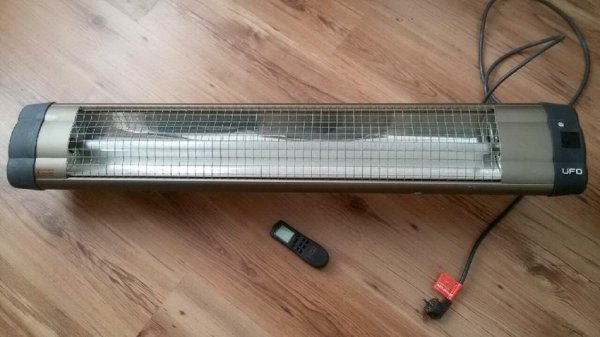
Photo 5. Infrared heater from the manufacturer UFO. The kit includes a remote control for adjusting the temperature of the device.
Features of operation
The main requirement for using infrared heaters depends on their location in the apartment. If there are wall and floor devices, they should never be covered with towels or other things. The distance to sockets and other objects should not be less than 1 m.
Useful video
Watch a video review of the infrared ceiling heater from the manufacturer Ballu.
Which device is better to choose for heating a private house
Infrared heaters are capable of heating a room of various sizes in a short period of time. To quickly create the desired temperature in the house, give preference to a device with a capacity of 100 W per 1 m2. Accordingly, to heat a room with an area 20 m2, you need to buy a heater 2 kWIf necessary, consult the seller and carefully read the manufacturer's instructions.
Such heaters are quite easy to maintain.You just need to wipe them periodically to remove accumulated dust.







